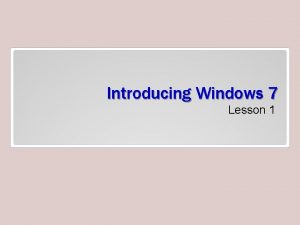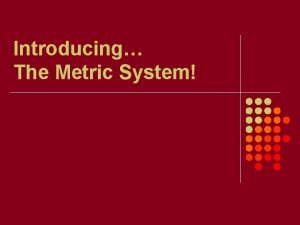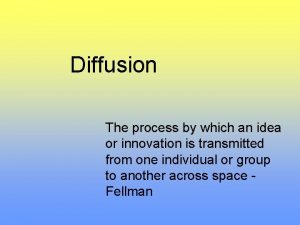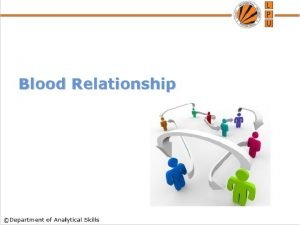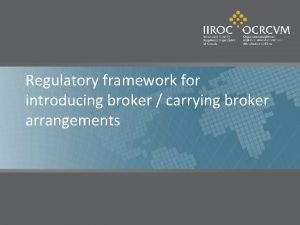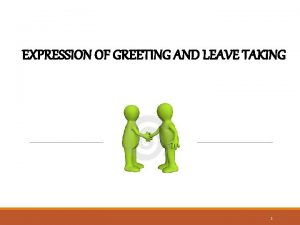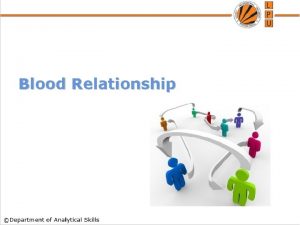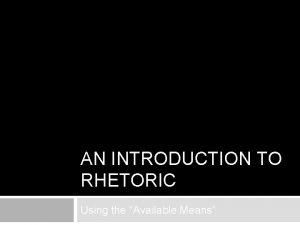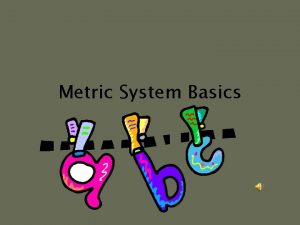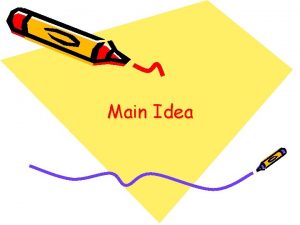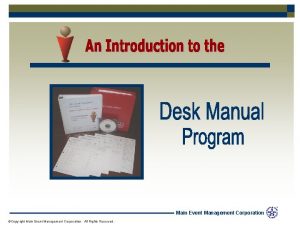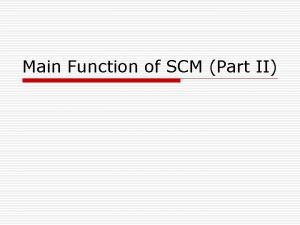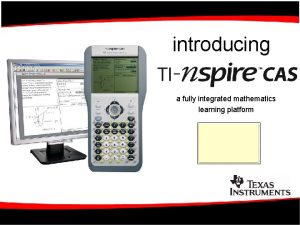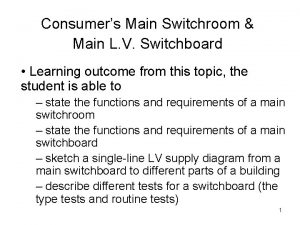PART 1 Introducing Management Introducing Management Main Learning
















































- Slides: 48

PART 1: Introducing Management

Introducing Management Main Learning Objectives: n n Understanding management concepts Characteristics of management Functions of management New Challenges facing managers

Introducing Management What is Management? n n Management is the attainment of organizational goals in an effective and efficient manner through planning, organizing, staffing, directing and controlling organizational resources. Organizational resources can be described by the 4 M’s include human beings, money, machines and materials.

Introducing Management has many definitions such as: n n n Louis E Boone & David L Kurtz- The use of people and other resources to accomplish objectives. Mary Parker Follet- the act of getting things done through people. Frederick Taylor defines Management as the art of knowing what you want to do in the best and cheapest way.

Introducing Management On the analysis of various definitions, the following characteristics of management emerge: n Management is a distinct process. n Management is an organized activity n Management aims at the accomplishment of predetermined objectives.

Introducing Management On the analysis of various definitions, the following characteristics of management emerge: • Management is both a science and an art. • Management is a group activity • Management principles are universal in nature • Management integrates human and other resources.

Introducing Management There is a difference between administration and management. The table 1. 1 below demonstrates these differences according to roles.


Introducing Management In his popular book 'Manage More by Doing Less' the well-known American. . . Mr. Raymond G. Leon has outlined the following emerging concepts: • Management by Communication • Management by Systems • Management by Results • Management by Participation • Management by Motivation • Management by Exception • Management by Objectives

Introducing Management For example, in a Management by Objectives (MBO) good goals are SMART (Specific, Measurable, Achievable, Results oriented and Time-related) goals. Peter Drucker, (1954, “The Practice of Management”); defined MBO as a systematic and organized approach that allows management to focus on achievable goals and attain the best possible results from available resources

Introducing Management Aims to increase individual and organizational effectiveness by aligning organizational goals and subordinate objectives. Clarifies and quantifies objectives to allow for monitoring, evaluation, and feedback throughout the hierarchy of objectives.

Features of Management • Many researchers have identified various characteristics or features of management. The principal ones are as follows: • Management is an activity concerned with guiding human and physical resources such that organizational goals can be achieved. Nature of management can be highlighted as: -

Features of Management • • • Management is Goal-Oriented Management integrates Human, Physical and Financial Resources: Management is Continuous: Management is an ongoing process Management is all Pervasive: Management is a Group Activity:

Functions of Management: • • Different experts have classified functions of management. According to Henri Fayol, there are five functions of management that span across all industries. They include: a. Planning b. Organizing c. Staffing d. Directing e. Controlling

a. • • • Planning is determining the objectives and formulating the methods to achieve them. It is more simply said than done. A job well planned is half done. During planning manager needs to ask the following questions: What am I trying to accomplish i. e. what is my objective? What resources do I have and do I need to accomplish the same? What are the methods and means to achieve the objectives? Is this the optimal path?

Types of Planning n n n Purposes or missions, Objectives-It is the ultimate goal towards which the activities of the organization are directed Strategies-general program of action and deployment of resources Policies-general statement or understanding which guide or channel thinking in decision making Procedures-states a series of related steps or tasks to be performed in a sequential way

Types of Planning n n n Rules-prescribes a course of action and explicitly states what is to be done Programs-comprehensive plan that includes future use of different resources Budgets-statement of expected results expressed in numerical terms

Principles of Planning n n n Take Time to Planning can be Top to Down or Bottom up Involve and Communicate with all those Concerned Plans must be Flexible and Dynamic Evaluate and Revise

Steps in Planning n n n n Determining the goals or objectives for the entire organization. Making assumptions on various elements of the environment. To decide the planning period. Examine alternative courses of actions. Evaluating the alternatives. Real point of decision making To make derivative plans.

Types of Managerial Decisions: n n Programmed Non-programmed. Mechanistic-It is one that is routine and repetitive in nature Analytical-It involves a problem with a larger number of decision variables

Types of Managerial Decisions: n n Judgmental-It involves a problem with a limited number of decision variables, but the outcomes of decision alternatives are unknown Adaptive-It involves a problem with a large number of decision variables, where outcomes are not predictable

b. Organizing Process of Organizing • Determine what is to be done/ Division of Work: • Assign Tasks: Departmentalization: • Link Departments: Hierarchy Development: • Decide how much Authority to Designate/ Authority, Responsibility and Delegation: • Decide the Levels at which Decisions are to be made / Centralization vs. Decentralization: • Decide how to Achieve Coordination:

Techniques for achieving coordination • • • Coordination by Rules or Procedures Coordination by Targets or Goals: Coordination through the Hierarchy Coordination through Departmentalization Using a Staff Assistant for Coordination: Using a Liaison for Coordination: Using a Committee for Coordination Using Independent Integrators for Coordination: Coordination through Mutual Adjustment:

c. Staffing can be defined as selecting and training individuals for specific job functions, and charging them with the associated responsibilities. Another definition is the number of employed personnel in an organization or program, also, called workforce.

d. Directing/Leading • • Provides positive and dynamic leadership Provides maximum opportunities Provides proper motivation of personnel Ability to deal with conflicts

e. Controlling • Feed Forward Control-Control that attempts to identify and prevent deviations before they occur is called feed forward control, sometimes called preliminary or preventive control. • Concurrent Control-Control that monitors ongoing employee activities during their progress, to ensure they are consistent with quality standards, is called concurrent control. • Feedback Control-In this case, the control takes place after the action. Sometimes called post-action or output control

Steps in the Control Process • • Establish Standards of Performance Measure Actual Performance Compare Performance to Standards: Take Corrective Action

Principles of Effective Control • • Effective controls are timely. Control standards should encourage compliance. Setting effective standards is important Use management by exception. Employees should get fast feedback on performance. Do not over rely on control reports. Fit the amount of control to the task.

1. 4 Managerial Skills Simply, managerial skills are the knowledge and ability of the individuals in a managerial position to fulfil some specific managerial activities or tasks. There are many definitions about skills that talk about talent. Talent is something personal related to an individual and presents a native gift from the nature about that something inside that talented person.

1. 4 Managerial Skills Robert Katz identifies three types of skills that are essential for a successful management process: • Technical, • Conceptual and. • Human or interpersonal managerial skills.

1. 4 Managerial Roles Mintzberg characterizes management using three categories and ten roles, each of which exhibits critical managerial skill sets useful for business leaders in a variety of contexts as follows: In order to better organize a long list of ten roles, they have been divided up into three categories interpersonal, informational, and decisional, as shown in figure 1. 1 below.

1. 5 Manager’s Roles

1. 5. 1 Interpersonal Role The managerial roles in this category involve providing information and ideas, as shown in figure 1. 2 below.

1. 5. 1 Interpersonal Role

1. 5. 1 Interpersonal Role Managers are expected to be: 1) Figurehead: 2) Leader: 3) Liaison:

1. 5. 2 Informational Role The managerial roles in this category include: 4) Mentor: 5) Disseminator-: 6) Spokesperson:

1. 5. 2 Informational Role

1. 5. 2 Informational Role Figure 1. 3 above shows that as the head of a team of any size or role within the organization, you will be the representative of that team when it comes to meetings, announcements, etc. Being a spokesperson is the final informational role on the list, and it is an important one because perception is often a big part of reality. Even if your team is doing great work, it might not be reflected as such to other decision makers in the organization if you aren't a good spokesperson.

1. 5. 3 Decisional Role 7) Entrepreneur: 8) Disturbance handler: 9) Resource allocator: 10) Negotiator: Figure 1. 4 Decisional Role

1. 5. 3 Decisional Role 7) Entrepreneur: 8) Disturbance handler: 9) Resource allocator: 10) Negotiator: See Figure 1. 4 Decisional Role

1. 5. 3 Decisional Role

1. 6 Levels of Managers The three levels of managers typically found in an organization are first-line management, middle-level management, and top-level management.

1. 6 Levels of Managers Figure 1. 5 above illustrates the following management levels: • First-Line Managers: • Middle Managers: • Top Management:

1. 7 What Make Manager Successful? Good managers are essential to any successful organisation. An exceptionally good manager achieves a: • Hard work • Smart work • Patience • Out of box thinking • Reading and acquiring knowledge • Ethical consciousness • Collaborative relationship • Perseverance Table 1. 2 Changing Challenges and New Trends for the Managers


1. 9 Types of Managerial Decisions: The following are the main types of decisions every organization need to take: • Programmed and non-programmed decisions. • Routine and strategic decisions. • Tactical (Policy) and operational decisions. • Organisational and personal decisions. • Major and minor decisions. • Individual and group decisions.

1. 9 Types of Managerial Decisions: Strategic planning is a starting point towards successful organization in such dynamic business environment and new trends and challenges. Strategic planning is an organization's process of defining its strategy, or direction, and making decisions on allocating its resources to pursue this strategy. It may also extend to control mechanisms for guiding the implementation of the strategy.

1. 9 Types of Managerial Decisions: Strategic planning became prominent in corporations during the 1960 s and remains an important aspect of strategic management. It is executed by strategic planners or strategists, who involve many parties and research sources in their analysis of the organization and its relationship to the environment in which it competes. The next sections will thoroughly explain and discuss all stages and key factors to success in strategic planning.
 Cuadro comparativo de e-learning
Cuadro comparativo de e-learning The future will
The future will What is the central idea of this passage?
What is the central idea of this passage? Void main int main
Void main int main Main part of seed
Main part of seed Main part of seed
Main part of seed Seed diagram labeled
Seed diagram labeled What are the 3 main parts of an essay?
What are the 3 main parts of an essay? Addition symbol
Addition symbol Part to part ratio definition
Part to part ratio definition Brainpop ratios
Brainpop ratios Technical description examples
Technical description examples Parts of the under bar
Parts of the under bar The phase of the moon you see depends on ______.
The phase of the moon you see depends on ______. 미니탭 gage r&r 해석
미니탭 gage r&r 해석 Signal phrase example
Signal phrase example Introduction to english linguistics exercises answers
Introduction to english linguistics exercises answers 1941-1882
1941-1882 Quote explanation sentence starters
Quote explanation sentence starters What is a counterclaim in writing
What is a counterclaim in writing Introduce yourself sample
Introduce yourself sample Talk boost tracker
Talk boost tracker Ma
Ma Ottava rima examples
Ottava rima examples Introduction of digestive system
Introduction of digestive system Kfc macro
Kfc macro Introducing integers
Introducing integers Mpls internet access
Mpls internet access Explanation sentence starters
Explanation sentence starters New market offerings
New market offerings Templates for explaining quotations
Templates for explaining quotations Define upgrade advisor
Define upgrade advisor Who invented the metric system
Who invented the metric system How to write a little bio about yourself
How to write a little bio about yourself Stimulus diffusion definition
Stimulus diffusion definition Blood relation means
Blood relation means Introducing the odyssey
Introducing the odyssey Informal letter exchange student
Informal letter exchange student Carrying broker
Carrying broker Introducing family members in french
Introducing family members in french Introduction to scaled agile framework
Introduction to scaled agile framework Politics definition
Politics definition Introducing flex pods
Introducing flex pods Response of leave taking
Response of leave taking Introducing neeta anil said
Introducing neeta anil said An introduction to rhetoric using the available means
An introduction to rhetoric using the available means Templates for introducing quotations
Templates for introducing quotations Templates for introducing quotations
Templates for introducing quotations Introducing the metric system
Introducing the metric system































